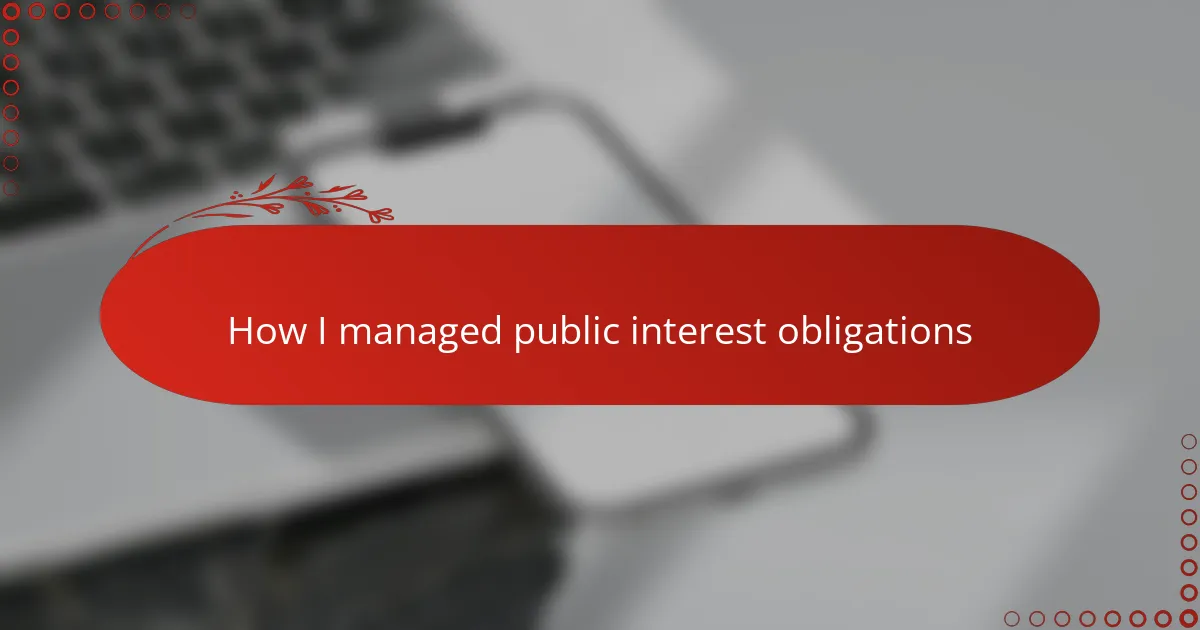Key takeaways
- Public interest obligations in radio broadcasting serve as a commitment to the community, balancing audience desires with essential information.
- Broadcasting is not just about content; it’s about creating connections and fostering inclusivity through meaningful programming.
- Legal requirements enhance trust and reliability, urging broadcasters to prioritize accuracy and fairness in their content.
- Engaging diverse audiences and feedback fosters dialogue, ensuring programming remains relevant and respectful to all community voices.
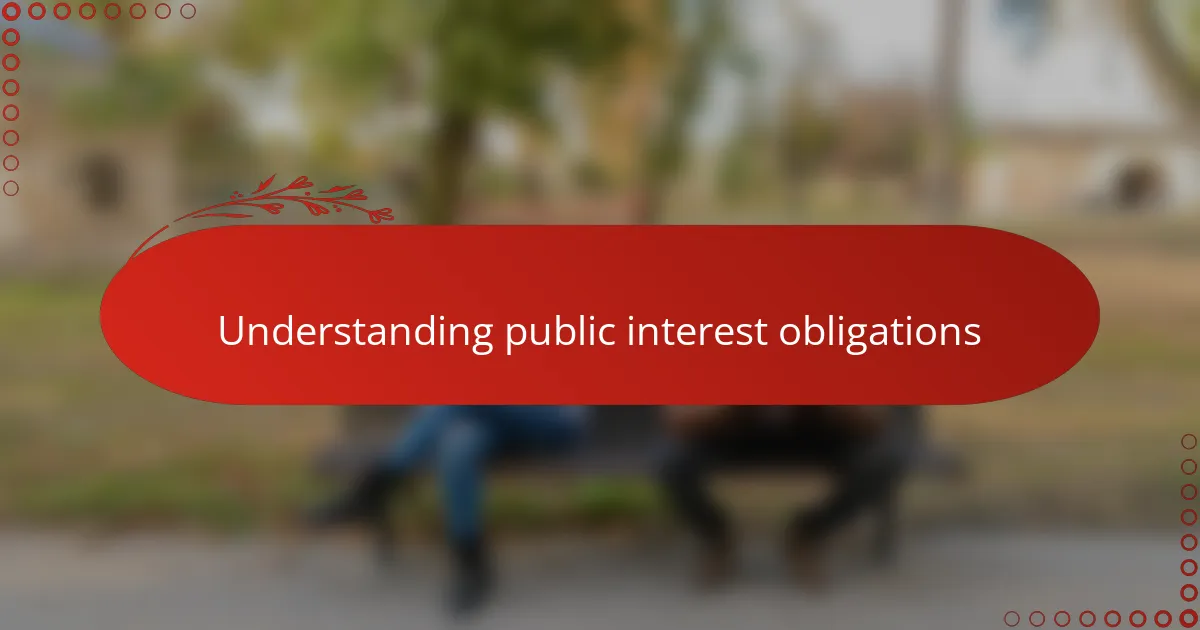
Understanding public interest obligations
Public interest obligations in radio broadcasting often feel like a heavy responsibility, don’t they? From my experience, they are more than just rules — they’re a commitment to serve the community’s needs, reflect its diversity, and provide valuable information. It’s about balancing what the audience wants with what they genuinely need.
When I first took on these obligations, I struggled to find the right mix between popular content and meaningful programming. It made me realize that serving the public interest is less about ticking boxes and more about understanding the heartbeat of the community. Have you ever paused to think about how your favorite radio station shapes your view of the world?
These obligations remind me daily that radio is powerful. It can educate, unite, and give voice to unheard stories. Understanding this has changed how I approach every broadcast, ensuring I stay true to the principle that radio is not just entertainment—it’s a public service.
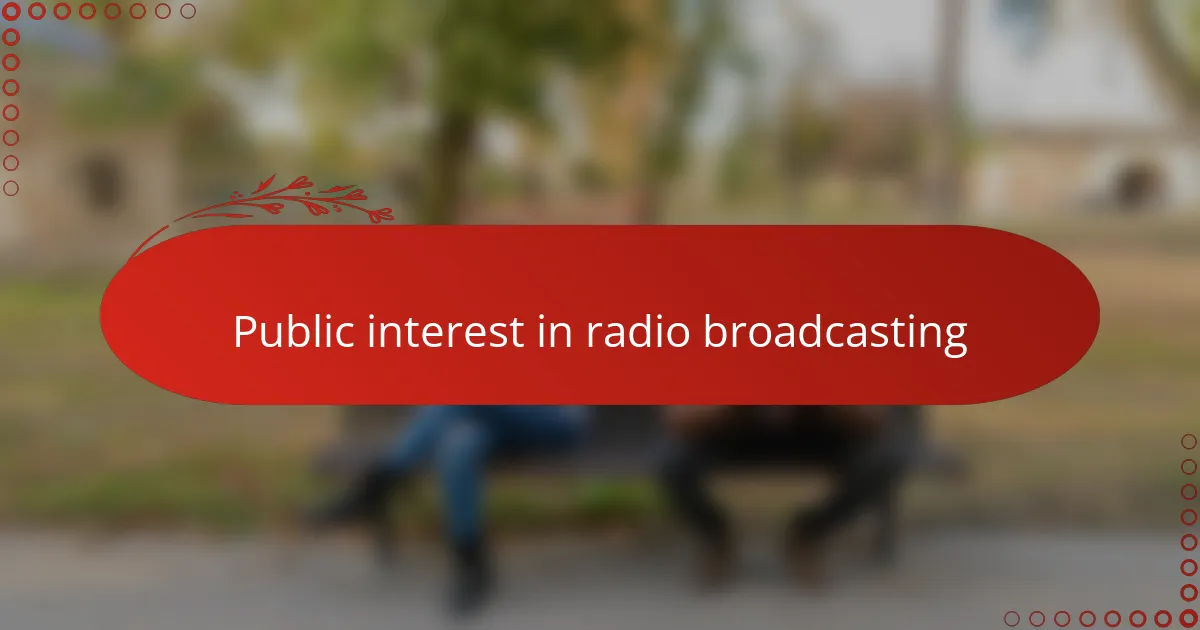
Public interest in radio broadcasting
Public interest in radio broadcasting, to me, is the invisible thread that connects every show to the community it serves. I’ve seen how focusing on content that truly matters to listeners transforms a station from mere noise into a trusted companion. Isn’t it fascinating how tuning in can sometimes feel like a conversation with a neighbor who understands your world?
I remember a moment when a local crisis unfolded, and our station shifted gears to provide crucial updates and support. That experience deepened my appreciation for the role radio plays beyond entertainment—it becomes a lifeline. Don’t you think that kind of immediate, relevant connection is what makes radio irreplaceable?
At its core, serving the public interest means more than spotlighting popular hits or celebrity chatter. It’s about creating a platform where diverse voices are heard and important issues are explored with honesty. From my perspective, this commitment shapes not just the broadcast but the very identity of a radio station.
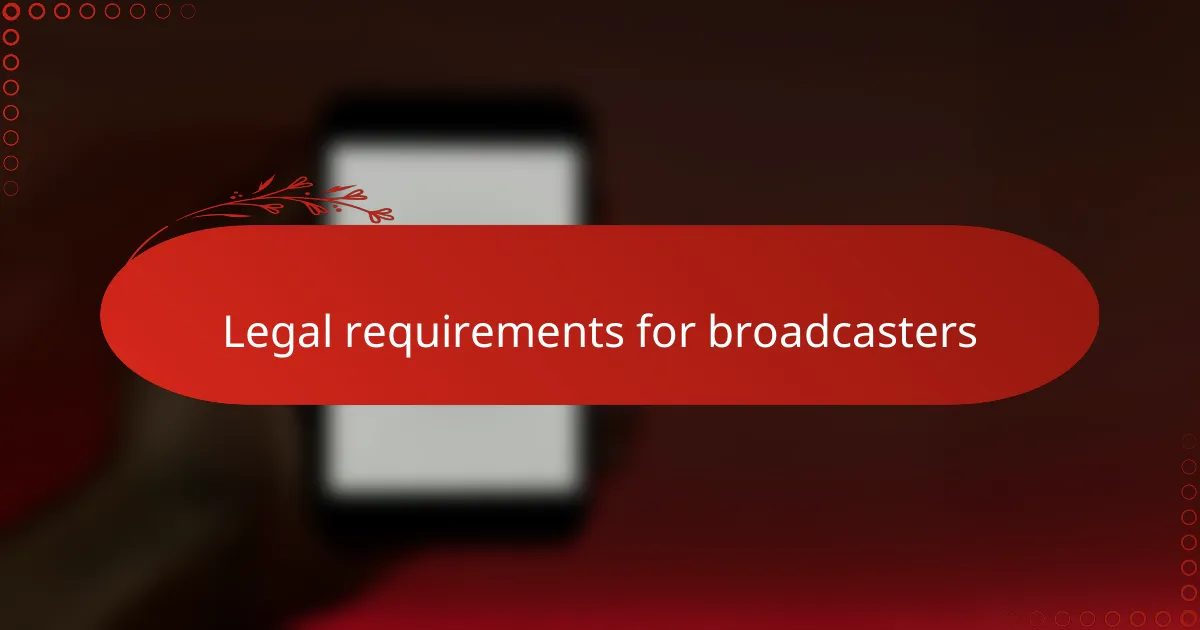
Legal requirements for broadcasters
Navigating the legal requirements for broadcasters wasn’t something I mastered overnight. When I first reviewed the regulations, I was struck by the fine line between creative freedom and compliance. Have you ever felt constrained by rules but understood they exist to protect something bigger? That’s exactly how I felt — these laws ensure that what we air serves the public good, not just commercial interests.
One specific challenge I faced was making sure content didn’t just meet technical standards but also respected fairness and accuracy. It was an eye-opener to realize how much responsibility rests on the broadcaster’s shoulders to avoid misinformation or bias. From my standpoint, these legal frameworks are less about restrictions and more about trust—building a bond with listeners who count on you for reliable information.
I also learned that staying legally compliant means staying informed and proactive. Regulations can change, and missing an update can have serious consequences. So I made it a habit to regularly engage with industry bodies and legal advisors. Doesn’t that ongoing vigilance highlight how broadcasting is as much about responsibility as it is about creativity?
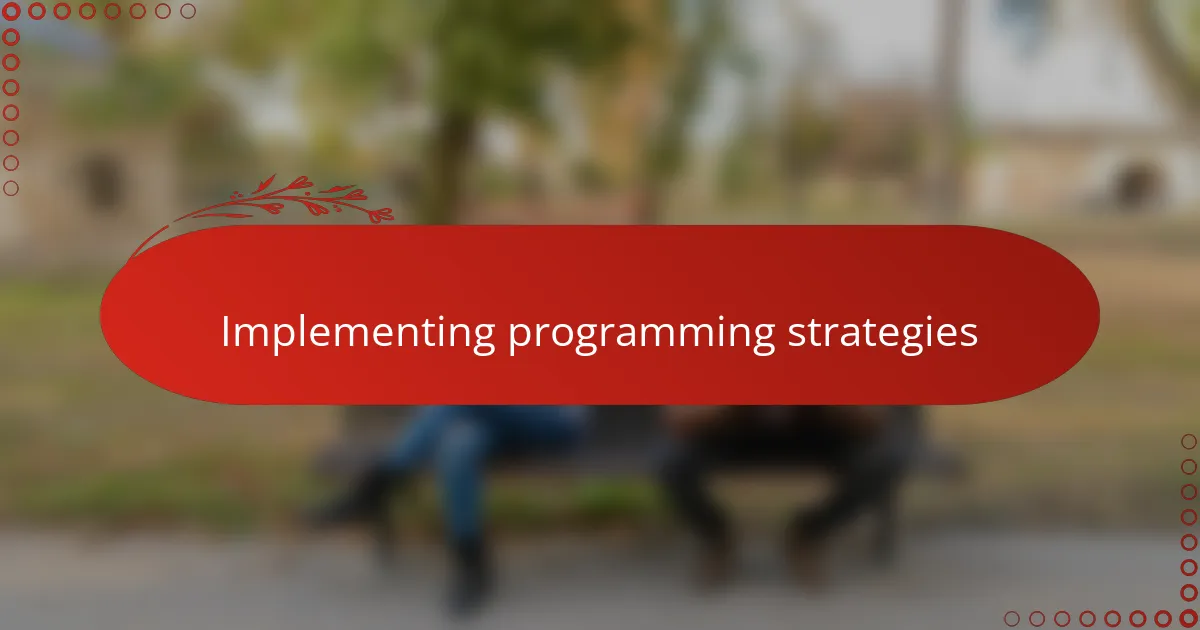
Implementing programming strategies
Implementing programming strategies was where theory met reality for me. I found that crafting a schedule wasn’t just about filling slots—it was about weaving stories and information that resonate deeply with listeners. Have you ever noticed how a well-timed program can shift your mood or spark a new idea? That’s the power I aimed to harness deliberately.
One approach I relied on was mixing educational segments with lighter content. This balance kept audiences engaged while ensuring the public interest was front and center. I remember a particular week when an investigative piece on local health issues drew more calls and feedback than any chart-topping hit had before—it proved to me that meaningful content doesn’t have to be sidelined.
But strategy didn’t stop at choosing topics. I made it a priority to involve community voices directly through interviews and call-ins. This created a dynamic where listeners felt heard and valued, which I believe is the heart of public interest broadcasting. Doesn’t that sense of connection make radio feel less like a broadcast and more like a conversation?
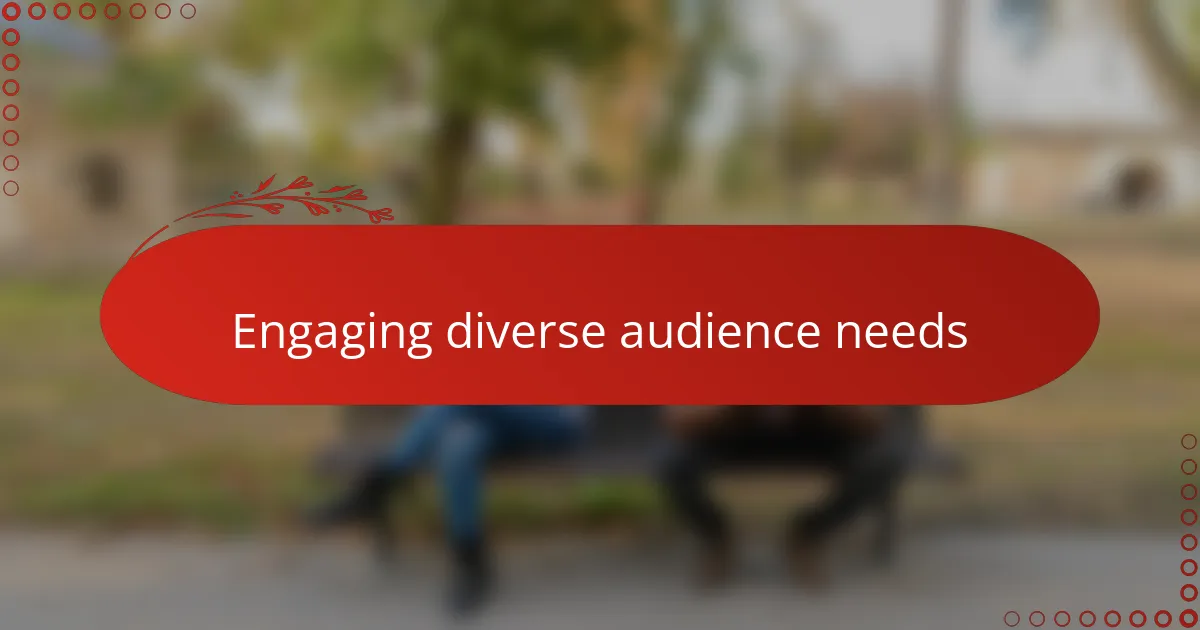
Engaging diverse audience needs
Meeting the needs of a diverse audience has always been a challenge that I approached with curiosity and respect. I quickly learned that no single format or topic fits everyone, so I made it a point to listen closely to different community groups and adjust content accordingly. Have you ever noticed how a program that resonates with one listener might completely miss another? That taught me the importance of variety and adaptability in programming.
One moment sticks with me: during a cultural heritage month, we featured stories and music from several ethnic communities. The response was overwhelming—not just in numbers, but in heartfelt messages from listeners who felt seen and celebrated. That experience reinforced for me that inclusivity isn’t just a box to check; it’s an invitation to build trust and belonging.
I also embraced feedback as a two-way street. Engaging diverse audiences meant creating spaces for conversation, whether through call-ins, social media, or community events. I kept reminding myself: how can we truly serve if we don’t give everyone a chance to speak? Listening actively helped me shape programming that felt relevant and respectful to all voices.
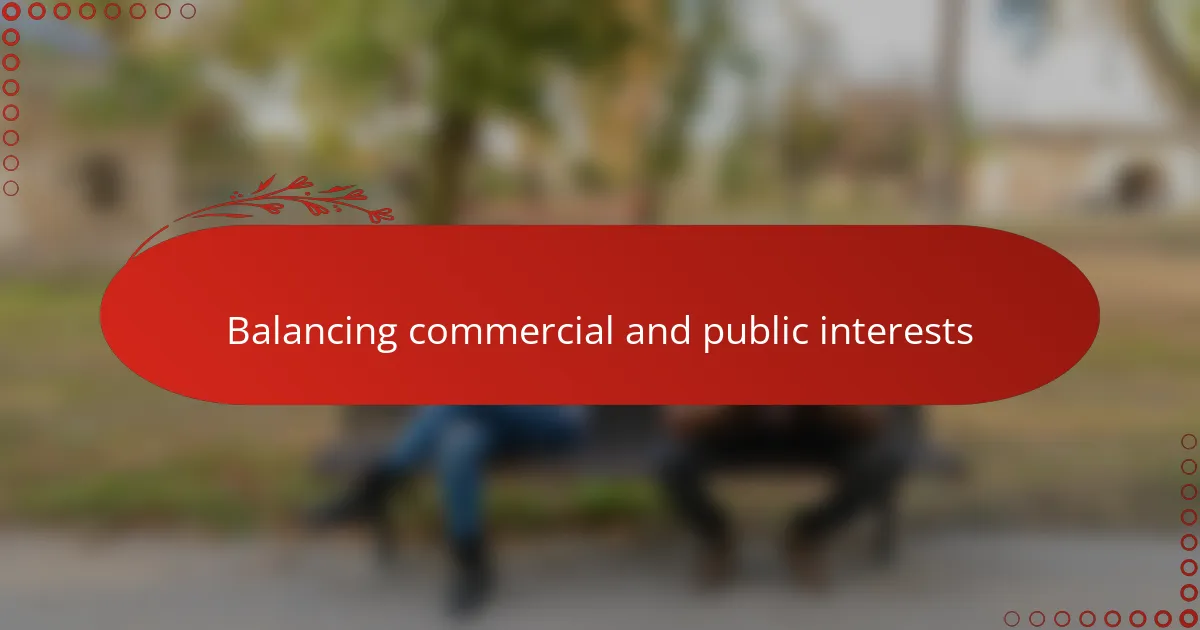
Balancing commercial and public interests
Balancing commercial goals with public interest often felt like walking a tightrope for me. At times, chasing advertising revenue tempted me to prioritize popular hits, but I kept asking myself: at what cost to the community’s voice? Finding that sweet spot where sponsorships support quality content without compromising values became my daily challenge.
There were moments when I worried that leaning too much into public service programs might drive audiences away, yet I also witnessed how meaningful stories built long-term loyalty. Isn’t it interesting that listeners reward authenticity even if it means less flashy content? Over time, I learned that being transparent with advertisers about our mission helped align commercial and public goals more smoothly than I expected.
One practical step I took was integrating sponsor messages within community-focused campaigns, making commercials feel like part of the conversation rather than interruptions. This approach not only maintained revenue but enhanced listeners’ trust. How often do you notice ads that genuinely respect your interests? Striving for that harmony is what I believe keeps radio both viable and valuable.
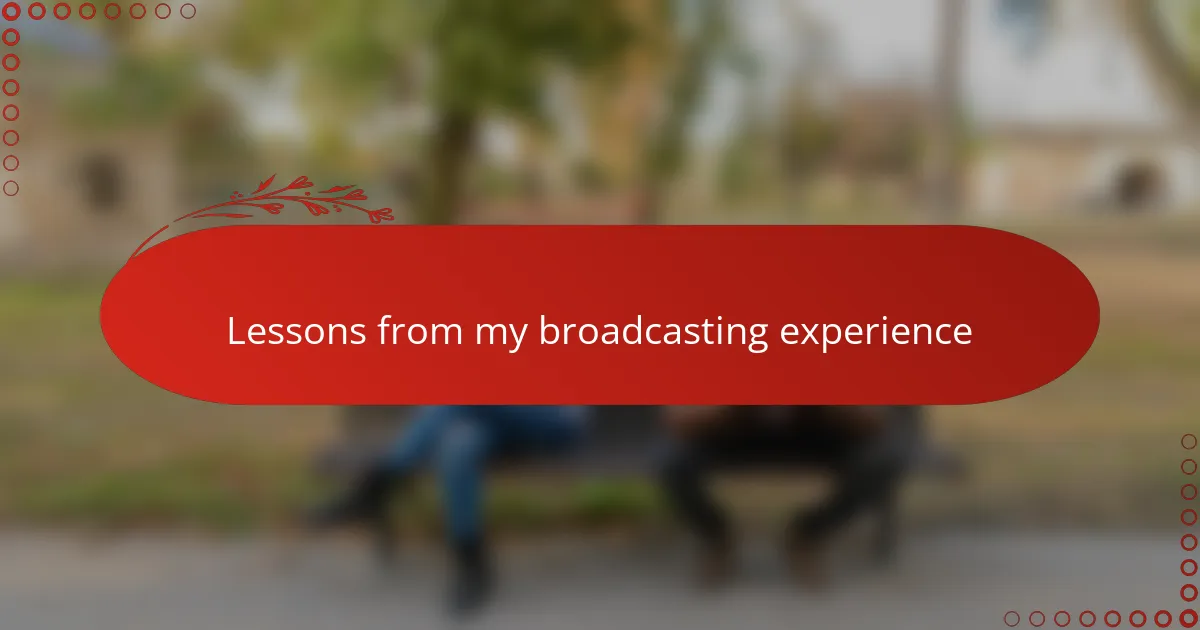
Lessons from my broadcasting experience
Looking back, one key lesson I learned is that public interest obligations aren’t a burden—they’re an opportunity to connect deeply with listeners. Early on, I worried these commitments might restrict creativity, but I found the opposite to be true: they pushed me to be more thoughtful and intentional. Have you ever experienced how real connection sparks unexpected inspiration?
I also realized the importance of constant listening—not just broadcasting. I remember times when feedback from audiences completely reshaped my approach, sometimes overnight. It struck me how much radio is a dialogue, not a monologue, and that embracing this back-and-forth makes public interest truly come alive.
Finally, managing these obligations taught me patience and resilience. Balancing community needs, legal frameworks, and commercial pressures felt like juggling flaming torches. Yet every challenge reinforced why public service in radio matters so much. Doesn’t knowing your work contributes to a greater good give you a sense of purpose worth every effort?
